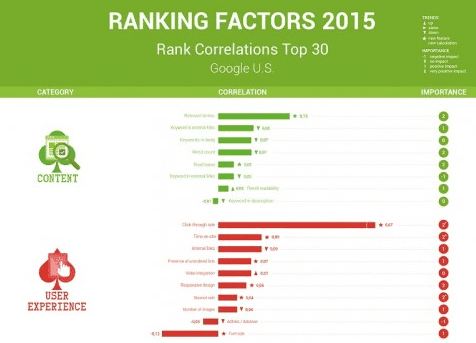
With the dramatic rise in mobile search, and Google moving to all artificial intelligence systems for 2016, it’s more essential than ever that companies develop strategies to boost their pages in the search engines to get top search result ranking.
Three important discoveries emerged from Searchmetrics’ 2015 annual analysis of the top 30 search results on Google for 10,000 keywords. The study analyzed common characteristics of pages with a high Google ranking and the factors that correlate with (or are more likely to appear on) these pages.
Quality content, not keywords
Most marketers know that content strategies based purely on inserting or including certain keywords within copy are dead. The study clearly shows that the emphasis today must be on creating relevant, high-quality content that is easily understood and comprehensively covers the topic.
While other studies have suggested that your content should be readable by a 5th grader, keep in mind the needs of your audience. If you’re writing for Global 1000 CEO’s, keep your content easy to read and digest for them (hopefully well above th grade level).
High-ranking pages cover topics in greater depth, touching on a variety of subjects, which also means they rank for more search terms and topics to assist in potentially attracting more traffic. This indicates that high-ranking sites are shifting their focus from using keywords based on search queries, to trying to understand the user’s intention as a whole and reflecting this in quality, logically structured content.
User experience matters, more internal links, more images
Web pages that ranked well in this study offered a more user-friendly experience. They are more likely to use features such as bullet points to present content in a more structured way, as well as more menus, buttons and other interactive elements that make a site easier to use.
While the use of responsive design is increasing, it’s interesting that only 30% of top-ranked pages use responsive design to automatically optimize pages for mobile devices.
High-ranking pages also tend to include more images and more internal links that visitors can use to find related information that adds value.
Goodbye, backlinks. Hello, link earning!
Backlinks continue to be important as a signal of quality and value. But this importance is waning.
While backlinks still show a fairly high correlation with rankings, their value is declining and is lower than last year’s study.
While link building is on the wane, link eaning by creating quality content is the way to go. The results show that to rank well, the emphasis is now on good, relevant content on sites that provide a quality user experience.
